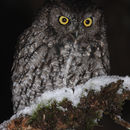en
names in breadcrumbs


Megascops kennicottii, commonly known as the Western screech owl, is a small grey owl belonging to the family Strigidae (Alden 1998). Until the 1980’s the Western screech owl and the similar Eastern screech owl (Megasopsis asio) were considered the same species, but the two are now seen as distinct (Kaufmann 2017). M. kennicottii is native to western North America, with its most common range consisting of coastal British Columbia, Washington, and Oregon. It can also be found in Idaho, California, Nevada, Colorado, Utah, Arizona, New Mexico, and Mexico, but its dispersal is much more patchy and uncommon in these areas (Cannings et al. 2017). Megascops kennicottii, can most commonly be found inhabiting coastal deciduous forests below six thousand feet (1,828 meters) in elevation. However, they are also known to occupy other biomes, such as the non-extreme deserts of Arizona and parks and suburbs in populated areas (All About Birds 2015). They are essentially non-migratory, with a limited range of around three hundred kilometers (Cannings et al. 2017).
Megascops kennicottii has a distinctly short, stocky body, with an average length of 20-25 cm.. It has a wingspan of around 60 cm and usually weighs from 100-300 g. (All About Birds 2015). Females are typically about four percent larger than their male counterparts. The external features of Megascops kennicottii vary slightly depending on their native region, but generally it has brown or grey-brown plumage. The coastal populations of the Pacific Northwest are more diverse in plumage, with seven percent of individuals colored a reddish brown. Its dorsal body feathers are grey or brown with a dark central streak and thin horizontal bars, while its ventral feathers are whitish but also have the dark central streak and horizontal bars. Its remiges (wing flight feathers) and rectrices (tail feathers) are also a brown or dark grey color with lighter, whitish bars, and its face is often pale, ranging from white to pale-brown or pale-grey with dark lateral borders. M. kennicottii is most distinguishable by its lemon-yellow eyes. Its legs and feet are mostly covered with feathers and its toe scales and claws are yellowish to greyish in color, becoming darker toward the tips. Its bill also begins yellowish and darkens to a bluish gray toward the tip (Cannings et al. 2017).
Despite its name, the Western screech owl does not screech, but instead has a call consisting of a series of accelerating hoots with a rhythm similar to that of a bouncing ball. Primarily nocturnal, it hunts a wide variety of small prey including rodents, amphibians, birds, fish, worms, and insects (Cannings et al. 2017). These owls practice the “sit and wait style” of hunting, patiently waiting and watching from above and swooping in on prey (All About Birds 2015). Wild Megascops kennicottii typically live one to eight years. It has been estimated that they begin breeding as one-year-old adults, and attempt to nest yearly. They are monogamous breeders, with females typically laying three to five eggs. They are referred to as “cavity nesters” because they nest in holes of a tree where branches have broken off, rather than piling sticks and leaves together (Cannings et al. 2017).